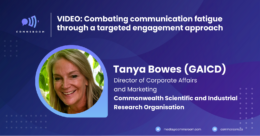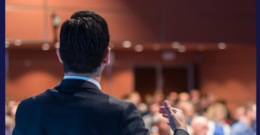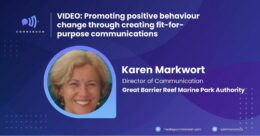Although Facebook and Instagram have somehow become a part of people’s everyday lives, many still do not know how to properly use their features to their best.
Good thing we’re joined today by our Featured Leader from Meta, Lauren Smallwood, a Partner Manager at the company.
Lauren is a seasoned professional in the media and advertising industry with more than ten years of experience.
Here, Lauren will help us better understand innovations by the social media giant so we can all maximise our use of its platforms.
Meta is known to advocate for coming together to connect and create change. What do you think are the steps that we need to take to achieve that?
The COVID-19 pandemic pushed governments to connect with their communities differently on a daily basis – with speed, at scale and in a way where unique needs of different audience groups were served. This shift in engagement opened the door to greater expectations from people – and government organisations needed to be prepared to meet, and even exceed those expectations, to build community and connection.
We recently conducted research in this space, surveying over 3,500 people across multiple countries, to learn more about how the government-community relationship is evolving and how people’s communication and connection expectations have changed.
One of the findings was that people see a number of benefits to communicating with their government using social channels, such as ease of communication, the ability to save time, convenience and having direct access to timely and up-to-date information.
Read also: Summer Goodwin of CSIRO on harmonising strategy experimentation and content consistency (commsroom.co)
People tell us it is important to receive timely, local updates in situations that directly affect them or that require them to take action, such as severe emergency weather warnings or major road closures. Products such as Facebook’s Local Alerts, which we launched in Australia last year, helps communicate time sensitive information and is available to all eligible state and territory health, police, and lead central government Page to take advantage of. The Local Alerts feature is designed to help authorities communicate urgent, need-to-know, or actionable information to communities in emergencies as well as less critical situations where timely information is valuable. When authorities with access to the product mark posts as Local Alerts, Facebook will send a notification to Page followers located in the affected area and mark the post as an alert to make it stand out in News Feed.
As a partner manager for Meta, what are the most common problems that you see your clients face and how do you help them deal with such?
There can be a variety of common challenges that Government organisations face, including understanding our advertising policies, how to measure the impact of their ads and account security.
We require advertisers to follow our Advertising Policies in addition to our Community Standards. The system is designed to review all ads before they go live and the process relies primarily on automated technology to apply our Advertising Policies to the millions of ads that run across our apps. We also place additional requirements on advertisers wanting to run ads about social issues, elections or politics. This involves turning on two-factor authentication, confirming your identity and location, and placing “Paid for by” disclaimers on your ads. The disclaimer will appear at the top of any ads you run and includes information on the entity that paid for the ad. Please note that each part of this process is subject to strict review and lead times.
Once approved and when creating campaigns, you must self-declare that your ads are about social issues, elections or politics before you submit them. The turnaround time for reviewing these ads is up to 72 hours. If you fail to complete any of these steps, your ads about social issues, elections, or politics will not be approved.
These ads are then entered into our public, searchable Ad Library for seven years. Any social issue, electoral or political ad on Facebook and Instagram that do not have the correct authorization or disclaimers will be removed from the platform and archived in the public Ad Library for seven years, as well.
Another common challenge is how Government organisations should use Facebook objectives effectively. In recent campaign analysis, we looked at the impact of using the reach objective to share important messages with a key audience. Based on over 400 brand lift studies run globally between December 2020 and December 2021, we’ve developed a statistical and qualitative meta-analysis which identifies and reflects on best practices that have been used to communicate with audiences about COVID-19. Our analysis showed that reach was most associated with cost effective ad campaigns and was marginally more associated with campaigns that were likely to influence audience perceptions. For organisations that have had success with post engagement or link clicks due to their media strategy, the analysis suggests these were also effective at influencing perceptions.
It’s important that all users, including Government, government officials and government agencies, are vigilant about security practices and we suggest they follow our recommended security practices such as turning on 2FAC etc etc. Two-factor authentication is a security mechanism that requires you to enter a specific code when someone tries to access your account from an unrecognised device.
We’ve also partnered with a national identity and cyber support service, IDCARE, to raise awareness about online scams. We recently ran a consumer awareness campaign to teach people how to identify scams and report them which reached approx 8 million users.
Learn how you can advance your use of the latest social media trends in our Social Media for Gov Summit!

For you, how should social media managers maximise their use of social media to enhance their channels’ reach and effectiveness?
I would recommend taking advantage of Meta platforms audience targeting tools to reach new audiences and strengthen your existing community. When targeting new audiences, explore using tactics such as lookalike targeting, or custom audience targeting, to expand your reach. A lookalike audience can help you reach new people because they share similar characteristics to the existing audience segment. Custom audience targeting can target people who have interacted with your content on Meta technologies.
Another tactic to enhance effectiveness and reach, would be to implement the Conversions API into your strategy. Conversions API helps advertisers use their own marketing data to optimize ad targeting, decrease cost per action and more accurately measure campaign performance.
Lastly, I would also encourage you to use Campaign budget optimization, which automatically manages your campaign budget across ad sets to get you the overall best results. Combining this with Automatic Placements will help you find a wider audience, and allow our delivery system to make the most of your budget.
Other than the Metaverse, can you share some developments or solutions that Meta plans to have in the future to help organisations connect better with their audience?
Overall, the shift to video is a direction we and the industry as a whole are focused on. Today, users spend 20% of their time on Instagram viewing Reels. We’re excited about the benefits that short-form video, like Reels, can offer to brands: more space to tell your brand story, captivate audiences with immersive creative and get discovered by people who may love your business. Reels also continues to be the fastest-growing format on Instagram, as more people watch Reels to be entertained, go deeper with their interests or discover new organisations and businesses.
In addition to Reels, we are always looking for new ways to start and manage conversations. The pandemic accelerated the usage of messaging services for seamless and personal support. Over 2020, during the height of the COVID-19 pandemic, total daily conversations between people and businesses on Messenger and Instagram grew more than 40%. Businesses using the WhatsApp Business API are already sending more than 100 million messages a day. In this seamless process, over half (53%17) of consumers want the ability to purchase directly through a messaging app and even more want the ability to customize products through chat functions (59%18).
We look forward to continued growth spurred by business messaging, or conversation and social commerce. It will be a game-changer because of its convenience and seamless friction.
You may also want to read: Communicating with Prospective Clients (commsroom.co)
Post Views: 58
Jaw de Guzman is the content producer for Comms Room, a knowledge platform and website aimed at assisting the communications industry and its professionals.






























